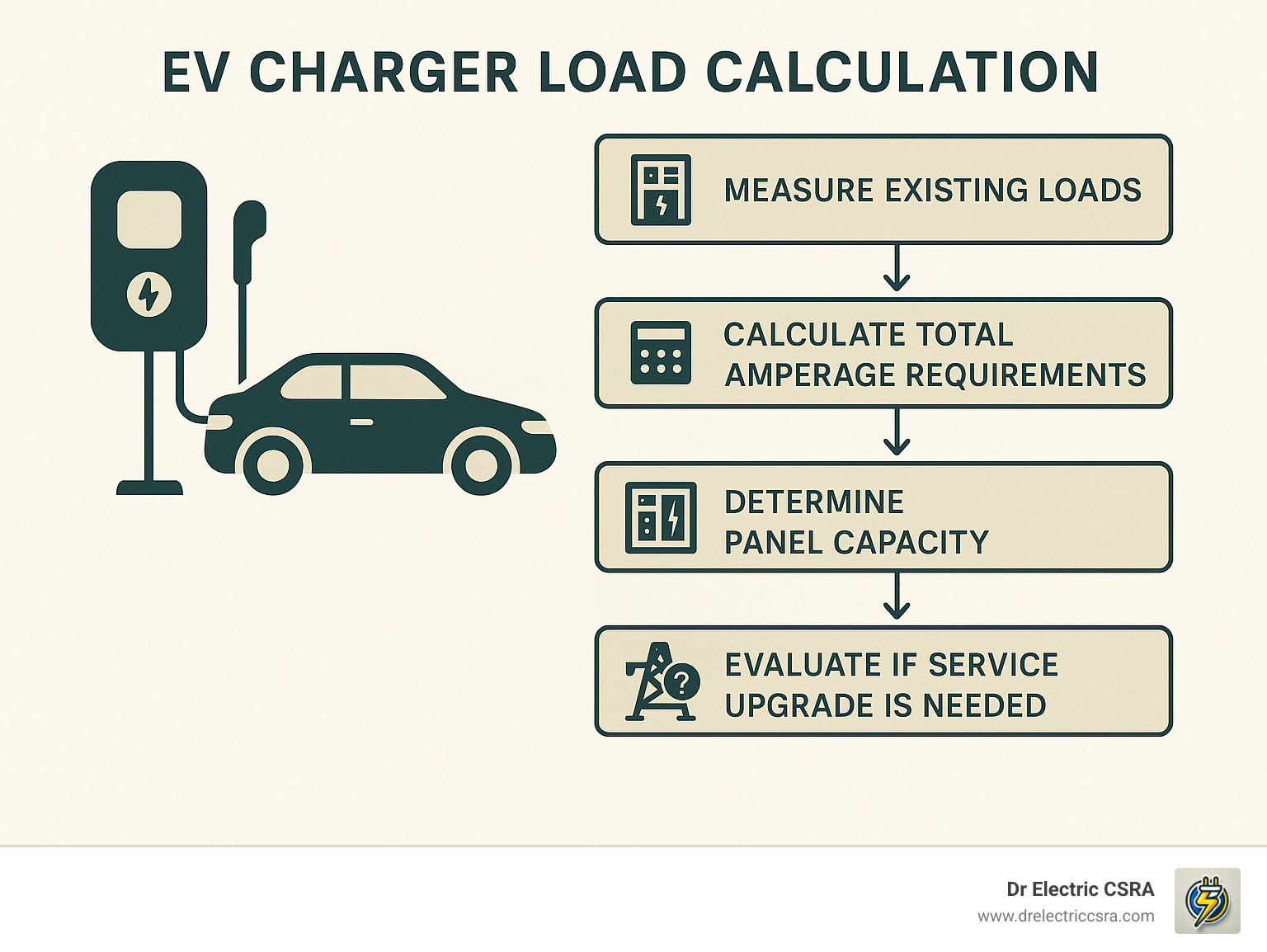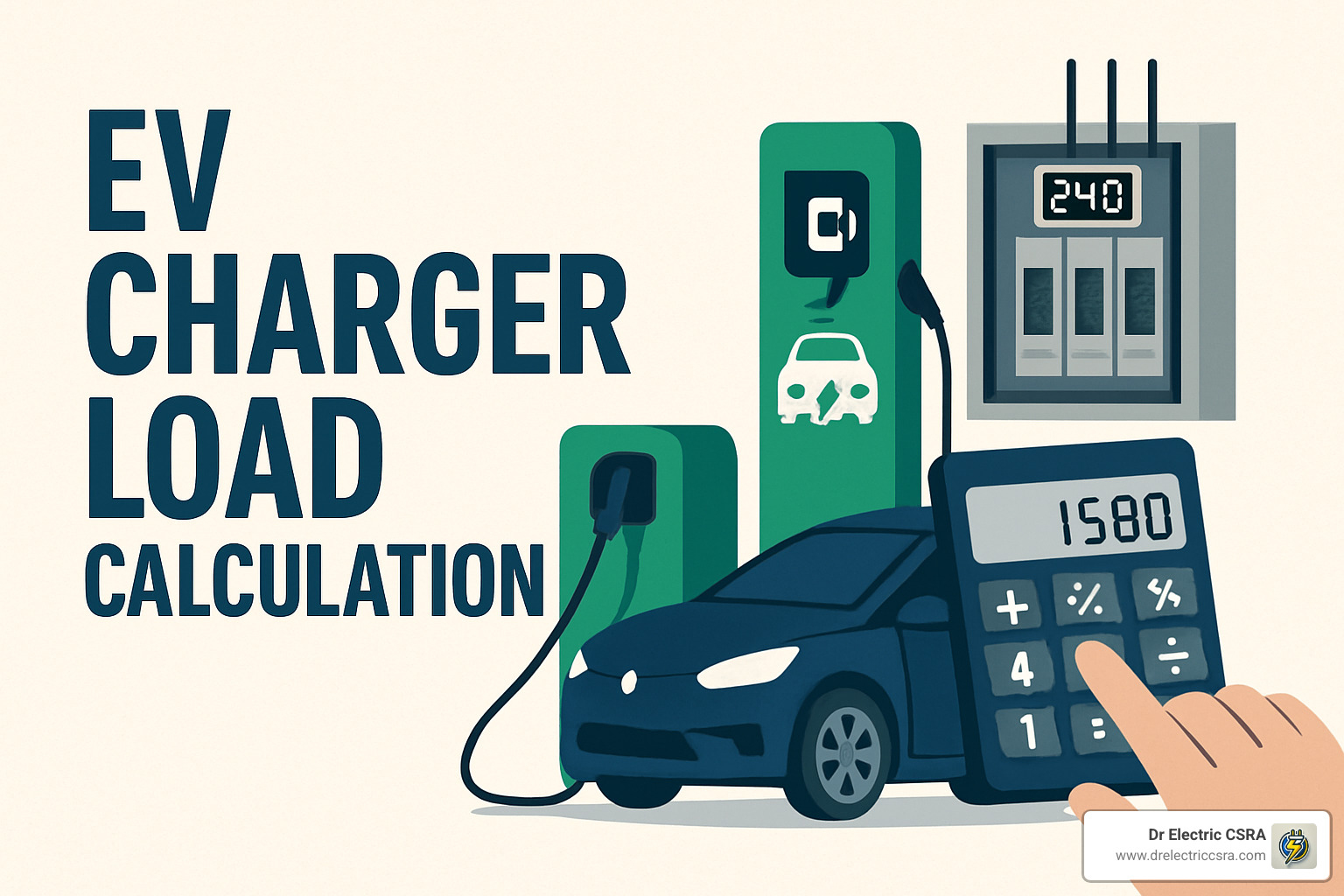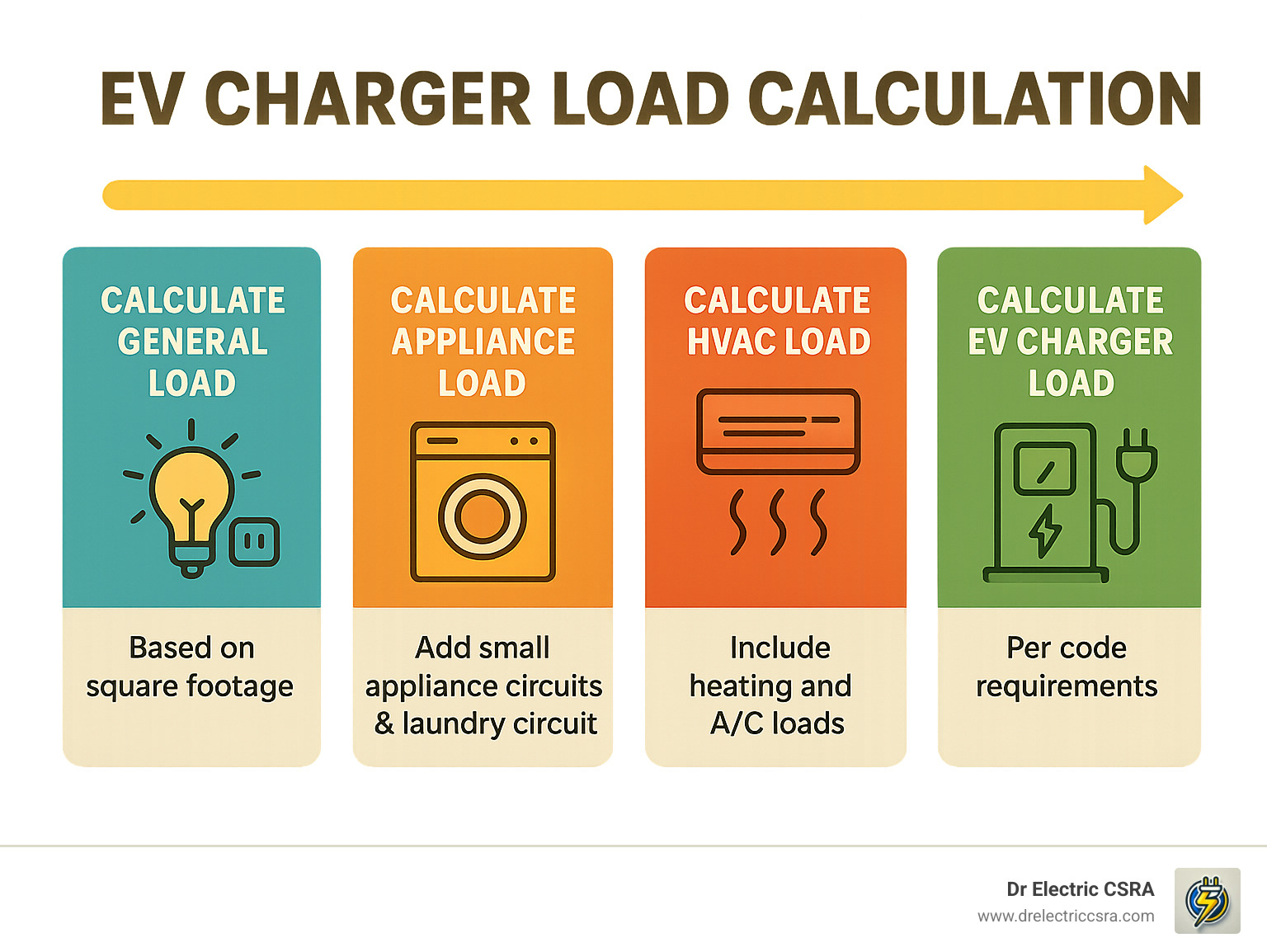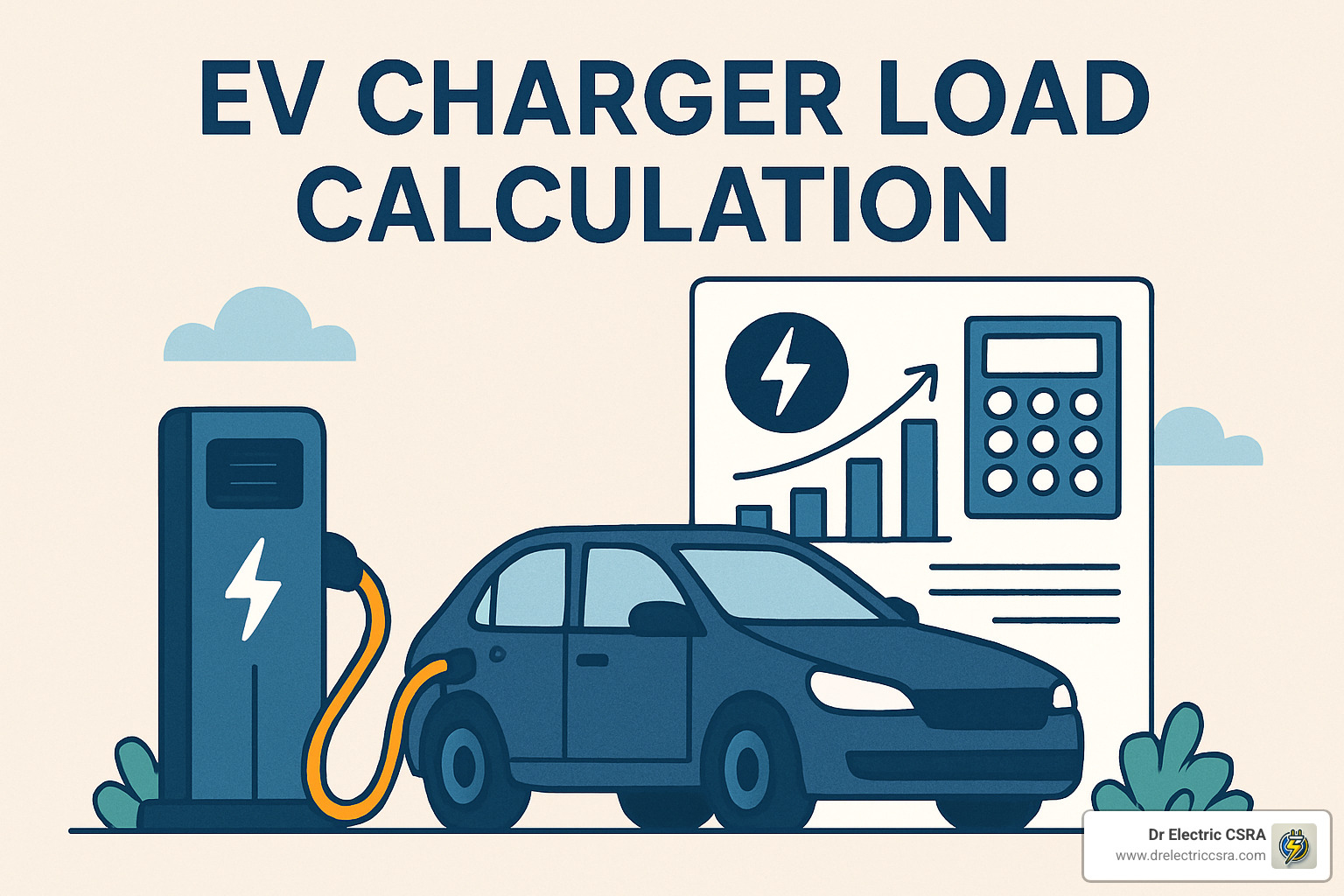Understanding the Critical Math Behind EV Charger Installation
An EV charger load calculation is a mathematical assessment that determines if your home’s electrical system can safely handle the additional power demands of an electric vehicle charging station. This calculation is essential before any installation to prevent overloaded circuits, tripped breakers, and potential fire hazards.
Quick Answer: EV Charger Load Calculation Basics
- Standard Level 2 charger load: Approximately 7,200 watts (7.2 kW) or 30 amps at 240 volts
- Calculation method: Sum all existing electrical loads + EV charger load, then compare to your service panel capacity
- NEC requirement: EV chargers must be calculated at 125% of their rated load as they’re considered continuous loads (operating 3+ hours)
- Minimum calculation: Per NEC 220.57, use either 7,200 VA (volt-amperes) or the nameplate rating, whichever is larger
- Service panel capacity: Most homes have 100-200 amp service; a Level 2 charger typically needs 30-50 amps
When considering adding an EV charger to your home, understanding your electrical capacity is crucial. A Level 2 charger can generate 3-4 times more electrical load than your air conditioner, making it one of the largest power draws in a typical home. Without proper calculation, you risk overloading your system or creating unsafe conditions.
Most homeowners are surprised to learn that EV chargers are treated differently in electrical calculations than other household appliances. While many household loads can be calculated with demand factors (assuming not everything runs simultaneously), EV chargers must be included at 100% of their rating in your total load calculation.
I’m Jesse Burnett, Master Electrician and founder of Dr. Electric CSRA, where I’ve personally performed EV charger load calculations and installations for hundreds of residential clients, ensuring each installation meets NEC requirements while optimizing for safety and efficiency.

EV charger load calculation terms at a glance:
– car charger installation
– transfer panel installation
– home EV charger vs public charging
EV Charger & Electrical Basics You Need Before Any Calculation
Let’s talk about your home’s electrical system before we dive into any math. Think of your electrical system like the plumbing in your house – electricity flows through your home in specific ways that we need to understand first.
Your home electrical system operates on three key concepts: voltage pushes the electricity (like water pressure), amperage is how much electricity flows (like the volume of water), and wattage tells us the total power being delivered when you multiply them together.
- Voltage (V): The “pressure” of electricity – standard outlets are 120V, while EV chargers typically use 240V
- Amperage (A): The “flow” of electricity measured in amps
- Wattage (W): The total power consumption (Volts × Amps)
Your electrical panel has a maximum capacity – think of it as the main water valve for your house. Most homes have either a 100A, 150A, or 200A panel, which represents the total electrical current your home can safely handle at once. When you’re adding a power-hungry EV charger, we need to make sure you’re not asking your panel to deliver more than it can handle.

Level 1 vs Level 2 Power Demands
When it comes to charging your electric vehicle at home, you’ve got two main options, and they’re as different as a garden hose and a fire hydrant when it comes to power demand:
Level 1 Charging is the easy option – just plug into a regular outlet:
– Uses your standard 120V household outlet
– Typically draws about 12 amps (1.44 kW)
– Adds roughly 4-5 miles of driving range per hour
– No special installation needed in most homes
– Has minimal impact on your home’s electrical system
Level 2 Charging is where things get serious:
– Requires a 240V circuit (same as your dryer or oven)
– Typically draws 30-50 amps (7.2-12 kW)
– Adds about 25-30 miles of range per hour
– Requires professional installation
– Creates a significant impact on your home’s electrical capacity
| Charger Type | Voltage | Typical Amperage | Power Draw | Charging Speed | Installation Requirements |
|---|---|---|---|---|---|
| Level 1 | 120V | 12A | 1.44 kW | 4-5 miles/hour | Standard outlet, no special installation |
| Level 2 | 240V | 30A | 7.2 kW | 25-30 miles/hour | Dedicated circuit, professional installation |
| Level 2 (High-Amp) | 240V | 40-48A | 9.6-11.5 kW | 30-37 miles/hour | Dedicated circuit, possible panel upgrade |
Most EV owners eventually want Level 2 charging – waiting overnight to add just 40 miles of range with Level 1 charging gets old fast! But that convenience comes with the need for a proper EV charger load calculation and potentially electrical service upgrades. Learn more about your options with our car charger installation services.
Common Residential Panel Ratings Explained
Before we calculate if your panel can handle an EV charger, let’s understand what your current panel capacity actually means for your charging options:
60 Amp Service is found in many older homes (pre-1970s). I’ll be honest – these panels are quite limited and almost certainly require an upgrade for Level 2 charging. They’re typically insufficient even for modern electrical demands without an EV charger.
100 Amp Service is common in homes built between the 1970s and 1990s. This might support Level 2 charging if your home has gas heat and other gas appliances (reducing electrical demand). There’s limited capacity for additional large loads, and you’ll definitely need a load calculation to confirm you have enough headroom.
200 Amp Service is standard in newer homes (post-1990s) and is generally sufficient for Level 2 charging. This provides ample capacity for modern electrical demands, though you’ll still want a load calculation for confirmation – especially if you have other large electrical appliances.
Your panel’s capacity isn’t just about the main breaker size—it’s also about the busbar rating (the main “highway” that distributes power) and whether there’s physical space for additional circuit breakers. Level 2 EV chargers require a double-pole breaker, which takes up two spaces in your panel.
If your panel is already full or your calculations show insufficient capacity, you may need an electrical repair or upgrade before installing your EV charger. Don’t worry – we help homeowners steer these decisions every day!
National Electrical Code Essentials for EV Charger Load Calculation
Let’s talk about the rulebook that keeps us all safe when installing EV chargers – the National Electrical Code (NEC). Think of the NEC as the safety playbook that electricians like us at Dr Electric CSRA follow religiously. The 2023 edition has some specific guidelines that directly impact your EV charger load calculation.
The key sections we need to pay attention to are Article 625 (covering all things EV charging), Section 220.57 (the math behind the calculations), and Section 625.41 (making sure your system doesn’t overload). These might sound like boring code numbers, but they’re actually the foundation of a safe installation!
Here’s something crucial to understand: your EV charger is considered a “continuous load” according to the NEC. What does that mean? Any electrical device expected to run for 3+ hours straight falls into this category. Since most of us charge our EVs overnight (definitely more than 3 hours), this classification matters a lot for your installation.
Because of this continuous load status, we need to:
1. Size your circuit breaker at 125% of the continuous load (giving that extra safety margin)
2. Calculate your EVSE load at either 7,200 VA or whatever the nameplate says – whichever is larger
3. Include the full 100% of your EV charger load in the final calculations
One thing that surprises many homeowners: the NEC specifically excludes EV chargers from the 75% demand factor that normally applies to multiple appliances in a home. In plain English, this means we can’t “discount” your EV charger load like we might with other appliances when doing the math.
For those who want to dive deeper into the code requirements, you can check out the latest NEC code details.
Why EV Charger Load Calculation Treats Charging as a Continuous Load
There’s good science behind treating EV charging as a continuous load. When electricity flows through wires for hours on end, heat builds up. This isn’t just a theoretical concern – it’s a practical safety issue.
Think about it like running a marathon versus a sprint. Your home’s wiring can handle short bursts of high electricity use (like when your AC kicks on), but continuous high loads for hours create sustained heat. This heat can gradually degrade wire insulation, increase resistance (which creates even more heat!), and in worst-case scenarios, potentially cause fires.
The 125% sizing rule isn’t just bureaucratic red tape – it’s a safety buffer. For example, if your Tesla charger draws 32 amps, we need to install a 40-amp circuit breaker (32A × 1.25 = 40A) and use wiring rated for that continuous load. This extra margin helps prevent overheating during those long charging sessions.
This is exactly why a proper EV charger load calculation matters so much – it ensures every component in your system can handle the sustained power demands safely.
Key NEC Sections Governing EV Charger Load Calculation
Let’s break down the specific code sections in everyday language:
NEC 220.57 requires your EV charger load calculation to use either 7,200 VA or whatever the nameplate says – whichever is larger. And unlike some other appliances, we must include 100% of this load in the final calculations. No discounts here!
NEC 210.19(A) focuses on the wiring itself, requiring conductors that can handle at least 125% of the continuous load. This prevents your wires from becoming the weak link in the system.
NEC 625.14 simply requires your charging equipment to be listed by a nationally recognized testing laboratory. This ensures your charger meets safety standards – no sketchy equipment allowed!
NEC 625.41 reinforces the 125% sizing requirement for circuit breakers, making sure your overcurrent protection is properly sized for continuous duty.
NEC 430.24 comes into play when calculating loads for homes with multiple motors running. This might affect your total load calculations if you have several motorized appliances.
At Dr Electric CSRA, we stay current with all these NEC requirements so you don’t have to. Our team ensures your installation not only works great but meets every safety standard in the book. After all, the code might seem complicated, but its purpose is simple: keeping your family and home safe while you enjoy the convenience of home EV charging.
For a deeper look at how we approach electrical work with safety in mind, check out our EC&M code basics article.
How to Perform a Residential EV Charger Load Calculation (Step-by-Step)
Let’s roll up our sleeves and walk through the process of figuring out if your home’s electrical system can handle that new EV charger. Don’t worry – I’ll break it down into manageable steps that follow the NEC guidelines while adding in the EV charger load.

First, we start with your home’s general lighting and receptacles. Take your home’s square footage and multiply it by 3 VA per square foot. Then add 1,500 VA for each small appliance circuit (you’ll have at least two) plus another 1,500 VA for your laundry circuit. For example, if you have a 2,000 sq ft home, that’s 6,000 VA for lighting, plus at least 4,500 VA for appliance and laundry circuits, giving you 10,500 VA.
Next, we need to account for all those permanently installed appliances. This includes your dishwasher, garbage disposal, water heater, and similar fixed equipment. Just add up their nameplate ratings. If you can’t find that information, you can estimate by multiplying the breaker size by 0.8 and then by the voltage.
Here’s where it gets interesting. The NEC lets us apply demand factors to these first two categories because not everything runs at once. If your total is under 10,000 VA, use that number. If it’s over, take the first 10,000 VA at full value, then add just 40% of the remainder. This reflects real-world usage patterns in a typical home.
Now add in your HVAC load – use whichever is larger between your heating or cooling system. For a heat pump, include 100% of its nameplate rating. No demand factors apply here.
The EV charger load calculation is next, and this is crucial: include either 7,200 VA or the charger’s nameplate rating, whichever is larger. Unlike other appliances, you must count the EV charger at 100% of its load – no demand factors allowed. This is a common mistake homeowners make when trying DIY calculations.
To find your total load, add everything up and then divide by 240V to convert to amperes. This final number tells you what your service needs to handle. Compare this to your panel rating – if your calculation shows 114 amps and you have a 100A panel, you’ll need to consider upgrading or implementing load management solutions.
Quick Example: 2,000 ft² Home + 40 A Charger
Let me walk you through a real-world example to make this clearer:
Imagine a 2,000 square foot home with a 100 amp service panel, gas heating, electric water heater, and you want to install a 40 amp Level 2 EV charger (9.6 kW).
For general lighting and receptacles, we have 2,000 sq ft × 3 VA = 6,000 VA, plus 3,000 VA for small appliance circuits and 1,500 VA for the laundry circuit. That’s 10,500 VA total.
Your fixed appliances include an electric water heater (4,500 VA), dishwasher (1,200 VA), garbage disposal (900 VA), and microwave (1,500 VA), totaling 8,100 VA.
Applying demand factors to these first two categories (18,600 VA total), we get 10,000 VA + (8,600 VA × 0.4) = 13,440 VA.
Add your central AC at 5,000 VA, and your EV charger load at 9,600 VA (40A × 240V).
Adding everything up: 13,440 VA + 5,000 VA + 9,600 VA = 28,040 VA. Divide by 240V to get 116.8 Amperes.
Since 116.8A exceeds your 100A service panel rating, you’d need either a panel upgrade to 200A or a load management solution before installing this charger.
Tools & Worksheets to Simplify the Math
If all these calculations seem overwhelming, don’t worry – you’re not alone! There are several resources that can help:
The NEC provides calculation forms in Annex D that offer a structured approach. Many utility companies also offer simplified worksheets specifically for EV charger installations that are typically accepted for permitting purposes.
While there are online calculators available, I’d recommend using them with caution and having a professional verify the results. At Dr Electric CSRA, we use professional-grade calculation tools to ensure accuracy and full compliance with local codes.
The math might seem complex, but getting it right is essential for safety and efficiency. If you’d like to learn more about our residential electrical services, visit our residential electrical page to see how we can help simplify this process for you.
Smart Solutions, Safety & Permitting After the Calculation
So you’ve crunched the numbers for your EV charger load calculation and now you know where you stand. Maybe your panel can handle that shiny new Level 2 charger with room to spare—or perhaps you’ve finded your electrical service needs some attention before you can power up your EV.

Panel Upgrade vs Load Management
If your calculations reveal your current panel just can’t handle the additional EV load, don’t worry—you’ve got options that fit different budgets and needs:
Option 1: Panel Upgrade
A full panel upgrade from 100A to 200A is like giving your home’s electrical system a complete makeover. It’s the most comprehensive solution, providing not just enough capacity for your EV charger, but plenty of headroom for future electrical additions too. This typically costs between $2,500-$4,500 depending on complexity, and often involves replacing your panel and potentially upgrading the service entrance conductors that connect to the utility.
Think of it as buying a bigger gas tank for your car—more capacity means fewer worries about running out of power. While it’s the pricier option, it’s also the most future-proof. Many of our Augusta homeowners find this investment worthwhile, especially as homes continue adding more electrical devices.
Option 2: Load Management Solutions
Smart energy management systems are the traffic cops of your electrical system. These clever devices monitor your home’s total electrical usage in real-time and automatically adjust your EV charging rate based on what else is running. When your AC kicks on, they’ll reduce the charging speed; when your house is using less power, they’ll ramp up charging again.
Solutions like the Tesla Neurio Energy Meter or similar smart controllers typically cost between $500-$1,500—significantly less than a panel upgrade. It’s like having an attentive DJ who constantly adjusts the volume to keep the neighbors happy while still enjoying the music.
Option 3: Circuit Sharing Devices
If you’re looking for a budget-friendly option and don’t mind a bit of coordination, circuit sharing devices let your EV charger share a circuit with another 240V appliance like your dryer. These clever devices (costing about $300-$800) ensure only one device operates at a time—kind of like taking turns at a four-way stop. This works particularly well if you charge your car overnight when the dryer isn’t running.
At Dr Electric CSRA, we’ve helped countless homeowners steer these options, and we’ve found that load management solutions often provide the sweet spot between cost and convenience. Need to upgrade your electrical service? Our upgrade electrical page has all the details.
Documentation You Need for Permits
Permits aren’t just bureaucratic red tape—they’re your assurance that your installation meets safety standards. Here’s what you’ll typically need to submit:
A properly completed load calculation worksheet shows authorities you’ve done your homework. Your site plan helps visualize where everything goes, while a detailed wiring diagram gives the technical specifics. Don’t forget the manufacturer’s specifications for your specific charger model and a statement of compliance affirming the installation will meet all applicable codes.
In Augusta, Evans, Grovetown, and Martinez, GA, our team handles all this paperwork for you—one less thing to worry about! We’ve steerd these local permitting processes hundreds of times and know exactly what each jurisdiction requires.
Also worth noting: many utility companies want a heads-up when you install a Level 2 charger. This isn’t them being nosy—it’s because multiple EV chargers in one neighborhood can potentially strain utility transformers. Your early notification helps them plan for the increased demand, potentially preventing neighborhood power issues down the road.
Top Mistakes to Avoid During EV Charger Load Calculation
Even the most careful DIYers can stumble when calculating EV charger loads. Here are the pitfalls we see most often:
Ignoring the continuous load rule is like forgetting to account for traffic when estimating travel time—it leads to unrealistic expectations. Always apply that 125% factor to your EV charger’s rated current.
Misreading nameplate ratings happens more than you’d think. Double-check that you’re using the actual amperage rating from the equipment nameplate, not the maximum circuit breaker size recommendation.
Many homeowners mistakenly apply demand factors to EV chargers, but unlike other appliances, EV chargers must be included at 100% of their rating with no reduction. It’s a key difference in the calculations.
For installations where your charger is far from your panel, forgetting voltage drop calculations can lead to performance issues. Longer runs often require larger wire sizes than the minimum based on ampacity alone.
Finally, while DIY calculations are a great starting point, skipping professional verification is risky. The safety of your home and family deserves the confidence that comes with professional expertise.
We’ve seen these mistakes repeatedly when homeowners attempt installations themselves. Our professional EV charger load calculations account for all these factors to ensure your installation is safe, reliable, and code-compliant.
Need help making sure your home is ready for an EV charger? At Dr Electric CSRA, we’re just a call away. After all, when it comes to electricity, it’s always better to measure twice and install once!
Frequently Asked Questions about EV Charger Load Calculation
Do I really have to count the EV charger at 100% of its rating?
Yes, this isn’t optional—it’s a safety requirement. Unlike your refrigerator or dishwasher, the National Electrical Code treats EV chargers differently because they typically run for many hours at a time (think overnight charging sessions).
When your car is plugged in for hours, it creates a continuous load that generates heat in your wiring. This is why the NEC specifically requires EV charger load calculation to include the full rating of your charger—either 7,200 VA or the nameplate rating, whichever is larger—with no reductions allowed.
I’ve seen homeowners try to apply the same demand factors they’d use for kitchen appliances, but this creates a genuine safety risk. Your electrical system needs to handle that sustained power draw without overheating, which is exactly why the code is so strict on this point.
How can I tell if my 100 A panel can handle a 48 A charger?
That 48 A charger is a power-hungry beast! It draws about 11.5 kW of power and requires a hefty 60 A circuit breaker (because of the 125% sizing rule for continuous loads). That’s a significant chunk of a 100 A service panel.
While only a complete EV charger load calculation can give you a definitive answer, here’s a quick rule of thumb I share with my customers:
If you have gas heating, a gas water heater, and a gas dryer, your 100 A service might handle that 48 A charger. But if you’re running electric heat, an electric water heater, or an electric dryer, your 100 A service is probably not up to the task.
I recently visited a home in Evans where the owner wanted to install a Tesla Wall Connector at maximum capacity. After running the numbers, we finded his 100 A panel was already at 85% capacity before adding the charger. The calculation saved him from potentially dangerous overloads.
What options exist if the calculation shows my service is undersized?
Finding out your electrical service can’t handle your new EV charger can be disappointing, but don’t worry—you’ve got options!
The most straightforward solution is upgrading your electrical service from 100 A to 200 A. This gives you plenty of headroom for charging and future needs, though it’s typically the most expensive option.
If that’s not in your budget, consider a smart load management system. These clever devices monitor your home’s total electrical usage and automatically adjust your charging rate to prevent overloads. I installed one last month for a customer in Martinez who wanted to keep her 100 A service but add a 32 A charger.
Another budget-friendly option is simply choosing a lower-amperage charger. A 16 A or 24 A Level 2 charger will still charge much faster than a standard outlet but draws significantly less power.
Circuit-sharing devices are another great solution—they allow your EV charger to share a circuit with another 240 V appliance (like your dryer), ensuring only one operates at a time.
At Dr Electric CSRA, we can help you evaluate which option makes the most sense for your specific situation, home layout, and budget. Many customers are surprised to learn that load management systems often provide the perfect balance of performance and cost.
Conclusion
Finding out if your home can handle an EV charger isn’t just about checking a box for permits—it’s about keeping your family safe while powering up your electric vehicle. A proper EV charger load calculation ensures your electrical system won’t be pushed beyond its limits, preventing potential hazards like overheated wires or electrical fires.
Throughout this guide, we’ve walked through the essential steps to determine if your home is ready for an EV charger. These aren’t just suggestions—they’re based on the National Electrical Code requirements that exist to protect your home and family.
Your EV charger will likely be one of the biggest power consumers in your home—often drawing more electricity than your refrigerator, air conditioner, and washing machine combined. This is why the calculations matter so much. Unlike other appliances that might run briefly, your car will typically charge for hours at a time, creating what electricians call a “continuous load” that requires special consideration.
The good news? Even if your initial calculations show your electrical service might be stretched too thin, you have options. Whether it’s upgrading your panel, installing smart load management systems, or choosing a lower-amperage charger, there’s almost always a solution that fits your needs and budget.
At Dr. Electric CSRA, we understand that these calculations can feel overwhelming. That’s why our team of licensed professionals is here to help Augusta homeowners steer the process from start to finish. We’ll run the numbers, secure the permits, and install your charger safely—giving you peace of mind along with convenient home charging.
We’ve helped hundreds of homeowners throughout Augusta, Evans, Grovetown, and Martinez transition to electric vehicle charging, and we’d be honored to help you too. Our in-house team is committed to delivering reliable, code-compliant solutions that stand the test of time.
Ready to power up your electric vehicle at home? Visit our full list of services to schedule your EV consultation today! We’ll help you charge safely, efficiently, and with complete confidence in your electrical system.






0 Comments